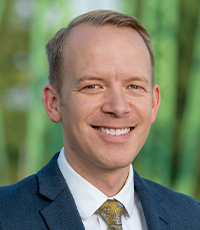By Steve Dinnen
DAFs, Jordan Richardson (pictured) reminds us, are the GOAT. In English, that means donor-advised funds are pretty much the greatest of all time when it comes to charitable giving. That certainly is the case at the Greater Des Moines Community Foundation, where Richardson is senior charitable giving adviser, since 45% of the more than $700 million being managed there has come through the doors as donor-advised funds.

A DAF is sort of like the charitable giving version of a mutual fund, in reverse. You send your donation to the Community Foundation, or another sponsor, and then select any number of nonprofit organizations where you want the money to go. You can direct your money to one group, two or 12, and you can have the money sent to them as often as you like. If you change your mind or see a new charity that you believe merits your benevolence, you can always add them.
Richardson and Sara Bonney, chief marketing officer at the foundation, said some donors are actively engaged in selecting gift recipients, others not as much. The donor sets the pace. Officials at the foundation can make recommendations, as well. And the donor determines the amount that is paid out and is free to change it up or down at any time.
Though donor-advised funds are not new, they grew in importance starting in 2017 with an overhaul of the income tax code. Congress then raised the standard deduction that taxpayers are allowed, and by doing so they practically wiped out Schedule A, where itemized deductions such as charitable gifts are listed. Richardson estimated that 90% of taxpayers now opt for the enhanced standard deductions.
Not to be outdone, the charitable giving industry ramped up the concept of “bunching.” For example, you normally give around $10,000 a year, every year. Once the tax code was revised, that $10,000 wasn’t high enough to reach the limitation threshold for an itemized deduction. But bunching would take three years’ worth, or a $30,000 gift at one time, and now you’ve cleared the bar to itemize deductions.
Of course, you have to dig a little deeper in your pocket for that $30,000 year. But you get the enhanced tax break in at least one year and then you can spread the fund money over three years for the same net effect. And that is the beauty of a donor-advised fund—and what led Richardson down the GOAT path.









